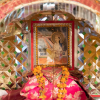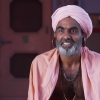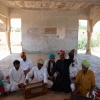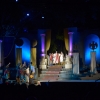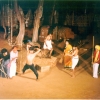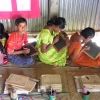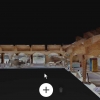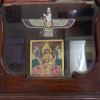Lalbhai Dalpatbhai Museum in Ahmedabad houses Indian sculptures, bronzes, manuscript paintings, drawings, miniature paintings, ancient coins and bead works. The museum was established by Muni Shri Punyavijayaji, Jaina scholar, and Sheth Kasturbhai Lalbhai, an industrialist. Its foundation was laid with the setting up of Muni Punyavijayaji Collection of Jaina art. With the donation of the Smt. Madhuri Desai Collection of sculptures (dating from the 2nd century onwards), a new building was constructed for the museum by architect B.V. Doshi with two designated galleries, Smt. Madhuri Desai Gallery on the ground floor and Muni Punyavijayaji Gallery on the first floor along with the N.C. Mehta Collection and Kasturbhai Lalbhai Collection of Indian miniature paintings, which was inaugurated in 1984.
The Smt. Madhuri Desai Collection was donated in 1977–78 and houses pieces like a Buddha head (5th century CE) in stucco from Gandhara, the earliest cult image of Rama (early 6th century) which belongs to the Gupta period and is from Deogarh, a rare figure of Matrika Indrani (6th century) from Shamlaji, the Adinath bronze image from Sirpur, and Chola sculptures (10th-12th century).
The Muni Punyavijayaji Collection houses the finest collection of paintings in the Gujarati Jaina styles. The Jaina pilgrimage paintings on cloth dated around 433 CE from Champaner is the earliest example of such a painting. Vijnaptipatra, painted in Agra by Ustad Salivahana in 1610, which refers to Jahangir's farman prohibiting animal sacrifices during the Jaina festival of Paryusana is housed in this collection. The illustrated manuscripts of the Kalakacharya Katha (c. 1430) in Mandu style, the Matar Sangrahani Sutra (dated 1583), painted by Charitara Govinda, the Sripara Rasa (18th century), several rare cosmological digrams called Adhidvipa (c.1440) and the Jaina Siddha-Chakra-Yantra can be found in this collection.
Among the objects gifted to the museum on behalf of Shri Arvindbhai are a Chola-style Nataraja (11th century) and an exuberant Nepali/Tibetan bronze Mandala (18th century).
The Shri Kasturbhal Lalbhai Collection comprises a large collection of Indian drawings obtained from Abanindranath and Gaganendranath Tagore family of Calcutta.





